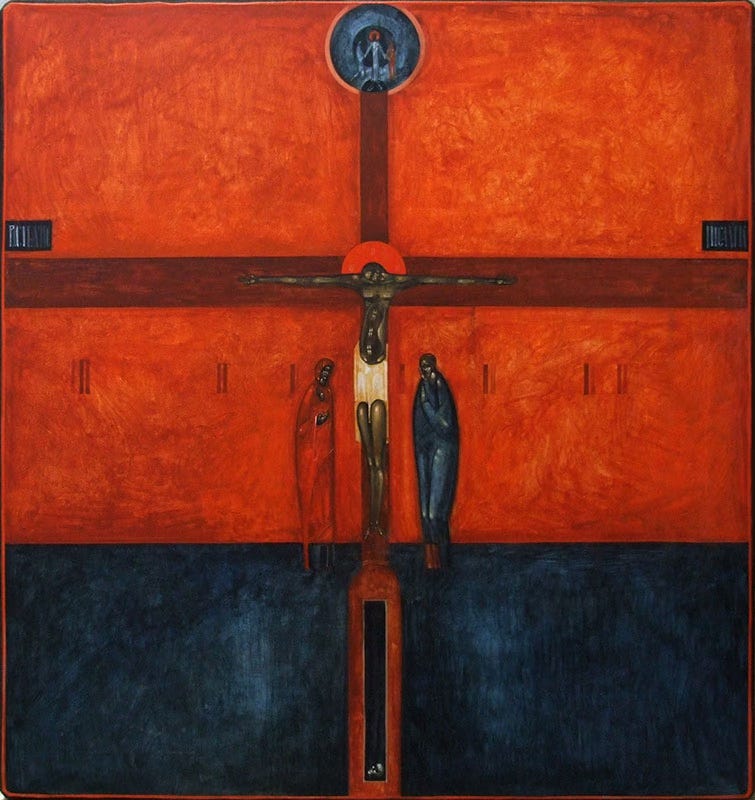
Welcome
This is the first week of our Lenten book study of The Crucifixion! Every Friday during Lent, I will post a short reflection on the assigned reading, a list of quotes, (possibly) a video discussing the readings, and perhaps some written reflections/questions/prayers from those participating in the study.
Let’s get into it!
Reflection
“The religious imagination seeks uplift, not torture, humiliation, and death. Therefore the principal purpose of this book about the crucifixion will be to strengthen the reader’s surmise that the cross of Jesus is an unrepeatable event that calls all religion into question and establishes an altogether new foundation for faith, life, and a human future.” - Fleming Rutledge
I remember when I first learned of the Christus Victor atonement theory as an undergrad. It shattered my “penal substitutionary atonement” coded brain. The idea that Christ’s death on the cross was not just to absorb God’s rage for me but that something happened to the fabric of reality in the moment brought new excitement to the faith I had been grafted into. Perhaps there was more to the cross than I could comprehend.
With this new-found theological framework, I espoused it in class, conversation, and passing. I lived up to the dreaded title of this newsletter, becoming a true “Sophomore Theologian.” It was an exciting step in my faith, yet the cross was skandalon.1 The cross was a stumbling block to my interpretation of it.
In Reverand Fleming’s introduction of The Crucifixion, she makes one thing very clear. No single theory can capture the immensity of power within the death of Christ on the cross. Rutledge seems less concerned with showing us the “meaning” than pointing us toward the “happening.” She hopes that the reader and preacher will be cast into the EVENT of the cross, not simply our interpretation of it. For Rutledge, everything, all of history, hinges on this singular, grand occurrence.
So, I would encourage you to lay down your theories before you go further into this work. If you’ve picked up this book hoping it would confirm your own theological bent, allow yourself to be tripped by the stumbling block of the cross of Jesus Christ. Because,
“No one image can do justice to the whole; all are part of the great drama of salvation. The Passover lamb, the goat driven into the wilderness, the ransom, the subsitute, the victor on the field of battle, the representative man — each and all of these and more have their place, and the cross is diminsihed if any one of them is ommitted.”2
The cross has become an image, a sign, a necklace to be worn, but as Rutledge states, “Christians do not simply look to the cross of Christ with prayerful reverence. We are set in motion by its power, energized by it, upheld by it, guaranteed by it, secured by it for the promised future because it is the power of the creating Word that ‘gives life to the dead and calls into existence the things that do not exist’ (Rom. 4:17).”3
Mother Fleming sets the tone for the intensity with which she treats the crucifixion throughout the book. Her love for Paul, historic Christianity, and stubbornness to not be confined by anything but the witness of the cross shines as she sets the stage for the reader. With this in mind, it is almost impossible to continue reading without prayer—without asking the Lord to make apparent true reality before our eyes. We do not give the cross its power; we are simply witnesses of it.
May the cross of Christ be a trap for our human wisdom—a stumbling block to our human strength. Amen.
Quotes
Furthermore, we are so accustomed to seeing the cross functioning as a decoration that we can scarcely imagine it as an object of shame and scandal unless it is burned on someone’s lawn. It requires a considerable effort of the imagination to enter into the first-century world of the Roman empire so as to understand the degree of offensiveness attached to crucifixion as a method of execution.4
None of the symbols, images, motifs, and themes “work” in any logical way, either as analogies or as theories to explain what God in Christ is doing on the cross.5
The Christ event derives its meaning from the fact that the three-personed God is directly acting as one throughout the entire sequence from incarnation to ascension to Last Judgement.6
The cross of Christ does not interpret itself by itself. Indeed, as some of the Protestant traditions recognize, the symbol of a cross per se can all too readily become a mere token or amulet leading to superstition and magical thinking. Even worse, wwhen detached from its significance, it can and often has become a sign denoting allegiance to a cause that mocks the very One who died in that way — the cross of Constantine, the Crusaders, and the Ku Klux Klan.7
Contrary to the story line in many “spiritual” journals, the biblical narrative does not tell of our journey toward God; it is the other way around.8
Christian theology and the Christian life are best found on the frontiers, where our thinking and doing are engaged by the dynamic tension between two seemingly contradictory truths.9
This is not a grim and joyless vocation. Even in the midst of suffering, Christian pilgrims on the cruciform path will find themselves drawn into the very heart of God.10
The Greek word for “stumbling block” or “trap.”
The Crucifixion, Fleming Rutledge, Pg. 7
Ibid, Pg. 14
Ibid, Pg. 3
Ibid, Pg. 6
Ibid, Pg. 13
Ibid, Pg. 18
Ibid, Pg. 20
Ibid, Pg. 33
Ibid, Pg. 37




